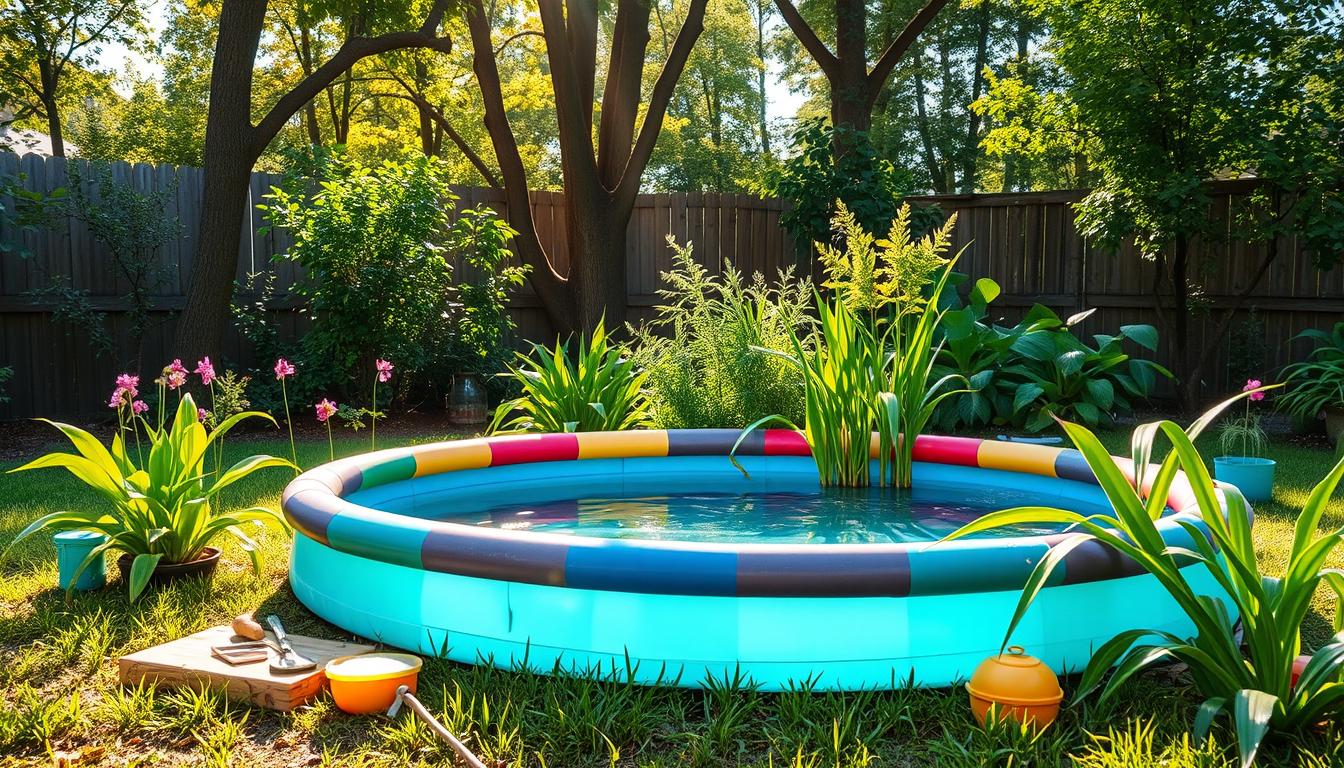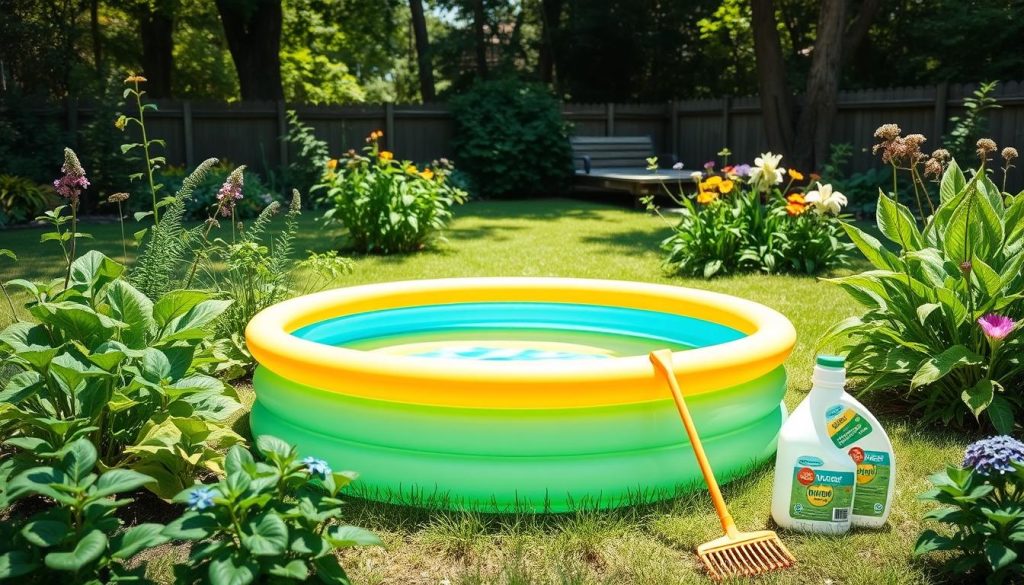
Summer brings fun times for kids splashing in kiddie pools. These pools create lasting memories and cool relief. But keeping the water clean and safe is crucial. Small pools lack filters to remove debris like leaves, dirt, and skin cells.
This raises the risk of spreading germs. That’s why it’s important to use natural methods for cleaning pool water. These methods keep children healthy while they enjoy their summer fun.
This guide explores how to keep kiddie pool water clean naturally. We’ll focus on eco-friendly kiddie pool maintenance and chemical-free pool cleaning tips. You’ll learn about organic kiddie pool sanitizers and practical solutions for crystal-clear water.
With these tips, you can create a safe, clean environment for your kids. They can enjoy their pool without harsh chemicals. Let’s explore natural ways to maintain your kiddie pool.
Understanding the Basics of Kiddie Pool Maintenance
Clean kiddie pool water is crucial for our children’s safety. Simple maintenance tips ensure a healthy swimming experience. Let’s explore how to keep kiddie pool water crystal-clear all summer.
Size and Capacity Considerations
Kiddie pools come in various sizes, from tiny inflatables to larger models. Knowing your pool’s capacity is key for effective maintenance. Smaller pools need less chemical treatment but are prone to rapid changes.
Temperature fluctuations and microbial growth happen faster in kiddie pools on hot days. This makes regular maintenance even more important for these small water bodies.
Water Quality and Maintenance Challenges
Fresh water in kiddie pools is easier to maintain due to their size. However, stagnant water can quickly become unsafe. Bacteria thrive in warm, untreated water, posing health risks to children.
Regular draining and refilling are advised, especially for pools without filters. Test chlorine levels and pH balance often. Adjust chlorine gradually and use baking soda for pH balance.
| Pool Size | Water Capacity (Gallons) | Chlorine Tablets Needed |
|---|---|---|
| Small Inflatable Pool | 30-50 | 1/4 tablet per week |
| Medium Inflatable Pool | 100-200 | 1/2 tablet per week |
| Large Inflatable Pool | 300-500 | 1 tablet per week |
Practical Tips for Usage and Hygiene
To maintain a clean and safe kiddie pool, consider these tips:
- Monitor children’s pool interactions and keep pets away to prevent contamination.
- Remove debris daily to reduce chemical needs and maintain water quality.
- Replace all water if a child has an accident in the pool.
- Use biodegradable cleaners and green treatments for an eco-friendly approach.
“A single 3-inch chlorine tablet can effectively maintain the water quality of a 10-foot inflatable kiddie pool for up to two weeks before a refill is necessary.” – Davy Merino, Pool Maintenance Expert with 15+ years of experience
Understanding kiddie pool maintenance basics ensures a safe swimming environment. Regular cleaning, testing, and safe purification methods keep pools clean all season.
Establishing a Regular Maintenance Routine
A clean kiddie pool ensures safe swimming for your little ones. Regular maintenance manages water quality and prevents harmful contaminants. Natural and eco-friendly methods can maintain a healthy environment without harsh chemicals.
Daily Inspection and Cleaning
Start with a daily inspection of your kiddie pool. Remove debris like leaves, twigs, and insects from the water. Use a fine-mesh net to skim the surface, keeping it clear and clean.
This simple task prevents organic matter buildup. It stops decomposition that can negatively impact water quality.

Water Quality Management
Monitor water quality for your children’s health and safety. Test the water regularly to ensure proper pH levels and sanitizer concentrations. Use organic sanitizers or natural cleaning methods for kiddie pools.
Baking soda can adjust pH levels. White vinegar serves as a natural disinfectant.
Weekly Deep Cleaning
Perform a thorough cleaning of your kiddie pool weekly. Drain the water completely and scrub surfaces with a soft brush. This removes algae or biofilm buildup.
Rinse the pool thoroughly after scrubbing. Clean all toys, floats, and accessories used in the pool. Weekly deep cleaning prevents harmful bacteria growth.
| Maintenance Task | Frequency | Benefits |
|---|---|---|
| Skimming surface debris | Daily | Prevents organic matter buildup and maintains clear water |
| Testing water quality | 2-3 times per week | Ensures safe pH levels and sanitizer concentrations |
| Deep cleaning and scrubbing | Weekly | Removes algae and biofilm, prevents bacterial growth |
Seasonal Maintenance and Storage
Prepare your kiddie pool for winter storage as swimming season ends. Clean and dry the pool thoroughly. Ensure no water remains that could freeze and cause damage.
Store the pool and accessories in a cool, dry place. Keep them away from direct sunlight and extreme temperatures. This protects your investment for next season.
By establishing a regular maintenance routine that incorporates safe pool water purification methods and eco-friendly practices, you can create a clean, healthy, and inviting swimming environment for your children to enjoy all summer long.
Natural Methods for Keeping Kiddie Pool Water Clean
Natural alternatives can keep kiddie pool water clean and safe. Green pool treatments offer a healthier swimming environment for children. Let’s explore some chemical-free and biodegradable cleaning tips for kiddie pools.
Using White Vinegar as a Natural Disinfectant
White vinegar is a safer, chemical-free alternative for managing algae growth. It acts as a natural disinfectant without harsh side effects. Add one cup of vinegar for every 100 gallons of water.
This ratio helps control algae and debris buildup without harming children. Vinegar works well in smaller pools where chemical use might be more noticeable.
Harnessing the Power of Baking Soda
Baking soda is a cheap alternative to bleach-heavy products for cleaning algae. It effectively scrubs away algae and debris, leaving the pool clean and fresh.
Mix baking soda with water to create a paste. Apply it to affected areas and gently scrub with a soft brush or sponge.
Removing Debris and Preventing Contamination
Remove debris from the pool before adding any cleaners. Skim the water daily to reduce the need for chemical treatments.
After scrubbing, rinse the pool thoroughly with a garden hose. Remove all traces of soap and cleaning products before refilling.
Allow the pool to air dry completely before refilling or storing. This helps prevent mold and mildew growth. Regular cleaning ensures a safe, enjoyable splash zone for kids.







